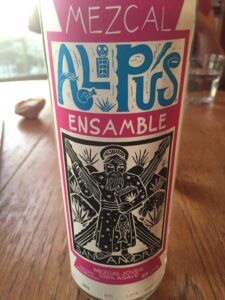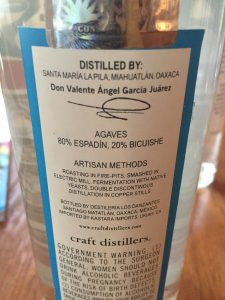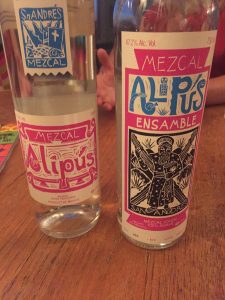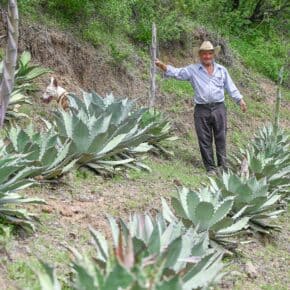The Alipús line continues to evolve. The latest addition is an ensamble which originally was designed to replace the San Andrés, now it appears it will complement it. The details:

- Location: Santa María La Pila, Mihuatlán, Oaxaca
- Agave: 80% Espadín, 20% Bicuishe
- Maestro Mezcalero: Don Valente Ángel García Juárez
- Quantity: 800 bottles in this batch. More to come.
- ABV: 47.2%
- NOM: O14X
Background:
As with its predecessor, the San Andrés Ensamble carries the pink label of the Alipús line because it is also made by maestro mezcalero Don Valente Ángel García Juárez in the same location as the original San Andrés. That original was made solely of espadín and quickly became one of the most popular labels in the Alipús line because it achieved a nice balance between roasted agave sweetness and rocky minerality. The ensamble refines that balance even further.

Keen observers will note that the ensamble bottle is smaller than the 100% espadín bottle. It contains the same amount of liquid, it’s just shorter. The ensamble also breaks with previous Alipús labels in presenting an image in addition to the brand name. This one is a linocut style image of San Andrés holding a massive crucifix in one arm, a bible in the other. There’s a really nice fish hanging from his belt repeated on the neck label because the biblical St. Andrés was a fisherman previous to his apostolic duties. For the non Spanish speakers in the house San Andrés is Saint Andrew, aka patron saint of Scotland whose flag reproduces the cross upon which he was supposably crucified. This saint means business, this mezcal does as well.
The original plan was to have the ensamble replace the 100% espadin San Andrés but now it seems like both will continue to coexist. That’s a good thing because both are fantastic bottles, tasting them side-by-side is quite an experience.

Tasting Notes:
The San Andrés Ensamble is a distinctive successor to the regular San Andrés. This one mixes in 20% of local bicuishe which adds flavor while highlighting everything in the espadin. I found it incredibly minerally balanced by a honeyed sweetness. The minerality verges on briny with flavors like Maldon salt.
For an incredible learning and tasting experience taste the ensamble side-by-side with the 100% espadín San Andrés. The flavor continuity is clear with the 100% espadín displaying more robust fruit and sublimated minerality. The ensamble really highlights that minerality, it’s racier and less viscous, which I can only assume comes from the bicuishe.











Max,
I have had the entire Alipus line and love them all; some of the best Mezcal I have had at any price.. So far my fave is the Santa Ana Del Rio. It has just the right amount of smoke, espadín and sweetness for my palate. Apparently somebody else agrees with me because it is now sold out at my store after I snagged the last bottle, and has not returned.
I have experimented with oak aging Tequila, Mezcal, Bacanora and Sotol for periods of six months to a year +, for about the last five years with wonderful results in producing delicious Extra Añejo style, creating three to five years or more agave spirits which ends up bearing a closer likeness to ultra smooth Cognac then Tequila. I still love the freshness and purity of Blanco, but really enjoy the soft, smoothness aging imparts to the Extra Añejo style. The unlocked flavours are readily incredible and rival the finest, most expensive Tequila and Mezcal anywhere. Those who’ve tasted it agree wholeheartedly. I save hundreds of dollars aging my own stock in this way. I actually now prefer mine to the expensive and many times over-priced Extra Añejo and Ultra aged Tequila and Mezcals.
I use new American, French and Hungarian oak barrels with a medium char, and toasted oak cubes both singularly and in combination.
I recently aged a bottle of Alipus, San Andrés, blanco to Extra Añejo standards and was amazed at the wonderful result. The color went from clear plata to dark amber with a wonderful oak-wood nose with spice, white-pepper, agave and distant notes of burnt butter and honey. Its almost gone now, hard to keep away from it and being enjoyed.
As you might expect, the better quality product you start with, the better the result. A dog is still a dog regardless, but even some aged dogs improve. Zapopan is an example of this at $12,00 a litre. Zapopan, however, is 100% agave and very decent stuff for the money. After firm Hungarian oak aging to Extra Añejo style, even this little pup earns some pedigree for good sipping smoothness and all-around finish.
A note about Tosba Mezcal: Its totally fresh and pure with wonderful true Mezcal depth and just the right, sweet, roasted maguey-agave flavours. I also oak aged a bottle of Tosba, Espadin blanco about a year ago with delightful results. The Tosba line was a welcome discovery offered to me by Victor Ramirez, owner of Ramirez Family Liquor Store in downtown Los Angeles, with their famous two-story Wall if Tequila. Not including Mezcal, they think they probably have over 600 Tequila brands in both LA stores. Tosba is somewhat recent to both the Mexican and U.S. market. Started by cousins in San Jose, California, it’s one of the better Mezcals out there and available at a good price, but hard to find. The owner of Liquid Experience in San Francisco, ordered it at my request and has done quite well with all the Tosba iterations, so far. It has become one of my favorite artisanals.
My background is radio broadcasting, corporate public relations, marketing and merchandising since about 1965. I currently live in Santa Rosa and am producing the First Annual Sonoma County Tequila and Mezcal Tasting . So far, everything looks good. Maybe I’ll see you at one of your upcoming events, Regards, Jerry